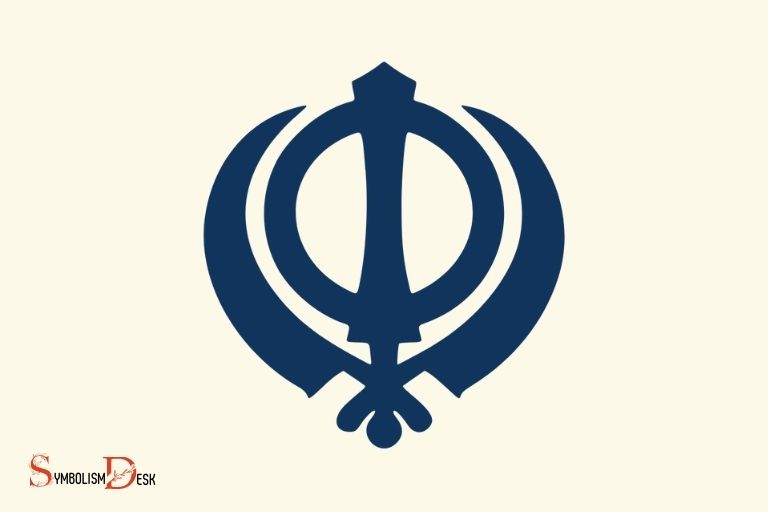What Does the Khanda Symbol Mean? Tenets of Sikhism!
The Khanda symbol represents the fundamental tenets of Sikhism. It comprises three symbols: the double-edged sword (Khanda), the circle (Chakkar), and the two single-edged swords (Kirpans).
The Khanda signifies divine knowledge, the Chakkar symbolizes the eternal nature of God, and the Kirpans emphasize the dual nature of spiritual and temporal power.
The Khanda is a significant symbol in Sikhism that embodies the fundamental beliefs of the community. The double-edged sword, known as the Khanda, lies at the center, symbolizing divine wisdom that distinguishes truth from falsehood.
The Chakkar, a circular object, denotes the eternal, infinite nature of God, showing that the Almighty has no beginning or end.
The two single-edged swords, or Kirpans, represent the dual concept of Miri and Piri in Sikhism, which refers to the integration of spiritual and worldly powers.
In Sikhism, the Khanda symbol is a fundamental emblem that holds great spiritual and symbolic significance.
It demonstrates the integration of divine knowledge, eternity of God, and the union of spiritual and worldly authorities
4 Elements: Meanings of the Khanda Symbol
| Element | Meaning |
|---|---|
| Chakkar (Circle) | The circle represents the eternal nature of God, without beginning or end. It symbolizes the unity and oneness of all existence. |
| Khanda (Double-Edged Sword) | The Khanda itself consists of a double-edged sword, representing the divine power of truth, righteousness, and justice. It signifies the struggle against injustice and the defense of righteousness. |
| Two Kirpans (Swords) | The two swords flanking the Khanda symbolize spiritual and temporal sovereignty. They reflect the balance between spiritual and worldly responsibilities that Sikhs aim to maintain. |
| Circle Surrounding the Khanda | The circle surrounding the Khanda and swords signifies unity, wholeness, and the eternal nature of the divine. It encapsulates the other elements and their interconnected meanings. |
Key Takeaway

Five Facts About The Khanda Symbols
What Is The Khanda Symbol?
The khanda symbol, also known as the sikh coat of arms, is one of the most notable icons of sikhism.
This symbol represents the sikh faith’s core principles and serves as a basic emblem for its followers. In this section, we will explore what the khanda symbol is, its origins, and its historical significance.
Definition And Interpretation Of The Khanda Symbol
The khanda symbol has three critical components that combine to form the emblem. The first component is chakkar, which represents the concept of continuity.
The second component is a double-edged sword called kirpan, which is an icon of divine knowledge.
The third component is called a khanda, which is a two-edged sword symbolizing spiritual power.
The khanda symbol has various interpretations, including:
- It represents the concept of unity
- It symbolizes protection
- It represents truth, courage and selfless service
- It represents one’s individual power
Origin Of The Khanda Symbol
The khanda symbol originated in india and specifically in the punjab region in the 17th century. Guru gobind singh, the tenth sikh guru, designed this emblem to represent the faith’s principles.
The symbol also reflects the martial character of sikhism and represents the strength of the sikh community. The symbol serves as a reminder of the Sikh community’s commitment to justice, equality, and resilience in the face of adversity. It holds deep historical and spiritual significance, shaping the identity and values of its followers. Understanding such symbols, much like deciphering the powerschool symbols meaning for parents, requires a closer look at their roots and the principles they embody.
Historical Significance Of The Khanda Symbol
The khanda symbol has historical significance and has been used in various ways, including identifying devout sikh followers and military regiments.
The symbol represents the core principles of sikhism, including:
- Equality and justice for all
- Spiritual and moral values
- Fight against oppression and tyranny
- Upliftment of underprivileged sections of society
The khanda symbol is an essential icon of sikhism, and its three components represent the essential principles of this faith.
With its diverse symbolic interpretations, the khanda symbol holds immense religious and historical significance.
Understanding The Components Of The Khanda Symbol
The khanda symbol is a powerful and significant emblem in sikhism, representing the core beliefs and ideals of the religion.
The symbol consists of three distinct images – the chakkar, khanda, and two kirpans. Understanding each component of the khanda symbol is crucial in comprehending the religion and its values.
So, let’s dive deeper into each one.
Description And Meaning Of The Chakkar
- The chakkar is the circular shaped image found within the khanda symbol. The circle represents the eternal nature of the soul and god, with no beginning or end.
- This symbol also signifies the cyclical nature of creation and life, ultimately leading to rebirth and the continuity of the cycle.
- The chakkar is a reminder of the importance of god and the eternal nature of the soul and its connection with the divine.
Description And Meaning Of The Khanda
- The khanda is a double-edged sword that stands at the center of the khanda symbol, symbolizing divine knowledge, the power of truth and justice, and the destruction of evil.
- The khanda represents the concept of miri-piri, where the spiritual and temporal forces work together in harmony to ensure justice and equality in society.
- The two edges of the sword signify the two qualities of god – mercy and justice, reminding us to strive for a balance of the two in our lives.
Description And Meaning Of The Two Kirpans
- The kirpan is a small sword that represents the necessity of self-defense and the protection of truth and justice.
- The two kirpans in the khanda symbol represent the twin values of miri-piri and the importance of balancing spiritual and temporal power for the betterment of society.
- It also serves as a reminder to follow the path of righteousness and to defend the oppressed and vulnerable.
The khanda symbol is a powerful representation of sikh beliefs and serves as a reminder to follow the path of righteousness, defend the oppressed and vulnerable, and balance spiritual and temporal power for the betterment of society.
Significance Of The Khanda Symbol In Sikhism
The khanda symbol is an important symbol in sikhism, representing both strength and unity. Its meaning and significance in the sikh religion go beyond its recognizable appearance.
Here we will discuss the role, use, and significance of the khanda symbol in sikhism, exploring what it represents in the sikh code of conduct.
Role Of The Khanda Symbol In The Sikh Religion
The khanda symbol holds a central role in the sikh religion, representing the concept of one god and the unity of sikhs.
It is a three-part symbol consisting of a double-edged sword, known as a khanda, two swords representing spiritual authority and political power, and a circle representing the unity of god, guru, and the sikh community.
The khanda symbolizes the importance of maintaining one’s religious and political beliefs while actively fighting against any injustice and oppression.
Use Of The Khanda Symbol In Sikhism
The khanda symbol is used in various aspects of sikhism, including the khanda di pahul ceremony, which symbolizes a commitment to the sikh faith and means rebirth.
It is also used to decorate sikh temples, scriptures, and clothing as a symbol of sikh pride and identity.
The khanda is also represented on the nishan sahib, the sikh flag, which is raised atop of every gurduwara (sikh temple) to represent the presence of god.
Khanda Symbol’s Significance In The Sikh Code Of Conduct
The khanda symbol plays an essential role in the sikh code of conduct, advocating self-discipline, commitment to the community, and the pursuit of knowledge.
It is a reminder to remain fearless and never shy away from taking action when standing up for justice and equality.
The khanda symbol serves as a guide for sikhs to carry themselves with respect, dignity, and honour, promoting peace and justice throughout the world.
The khanda symbol is a significant symbol in sikhism, representing the core principles of the sikh faith. It emphasizes the importance of maintaining religious and political beliefs while actively fighting against injustice and oppression.
The khanda symbol encourages sikhs to live their lives with respect, dignity, and commitment to their community while embracing the unification of god and guru within their lives.
The Khanda Symbol as a Cultural Icon
The khanda symbol is a cultural icon that represents sikhism’s core values. A distinctive feature of the sikh faith, the symbol holds a significant meaning for its followers.
It consists of three components: two crossed kirpans (traditional daggers) with a chakkar (a circular weapon) at the center, surrounded by a double-edged sword with the khanda symbol’s name written on it.
In this section, we will explore the khanda symbol’s representation and influence in sikh culture, its adoption by non-sikh cultures, and its significance as a symbol of unity and strength.
Khanda Symbol’s Representation And Influence In Sikh Culture:
- The khanda symbol is an integral part of the sikh identity and is often displayed in gurdwaras (sikh temples) and on the nishan sahib (the sikh flag).
- The symbol is a representation of the beliefs and values of sikhism, such as equality, justice, and freedom.
The two kirpans in the khanda symbol signify spiritual and political sovereignty represented in dual purposes:
- Protecting the weak and fighting against injustice.
- The chakkar signifies the oneness of god with no beginning or end.
- The double-edged sword represents the power and strength needed to protect the righteous path.
- The khanda symbol signifies a call to action to stand up for what is right, making it a powerful and inspirational cultural icon for sikhs around the world.
Adoption Of The Khanda Symbol By Non-Sikh Cultures:
- The khanda symbol has been embraced by many non-sikh cultures and is often used as a universal symbol of unity, strength, and freedom.
- The symbol is popular among martial arts enthusiasts and is also used in several indian army regiments, such as the sikh regiment.
- The symbol is also found on many flags, coat of arms, and emblems of different regions, including the indian states of punjab and haryana.
The Khanda Symbol As A Symbol Of Unity And Strength:
- The khanda symbol represents the unification of divine power. It is a symbol of the sikh identity and a reminder of the core values of sikhism.
- The symbol promotes unity among sikhs, symbolizing their strength and solidarity.
- It inspires people to stand up for their beliefs and fight against injustice, promoting community and providing strength to the broader sikh community.
- The khanda symbol serves as a testament to the sikh spirit and is cherished by sikhs worldwide, providing them with a sense of unity in diversity.
The khanda symbol is a cultural icon that represents sikhism’s core values, such as equality, justice, and freedom.
Its popularity among non-sikh cultures makes it a symbol of unity and strength. It is a powerful reminder of the sikh identity that inspires loyalty, courage, and fortitude to stand up for what is right.
What Does the Landing Eagle Symbolize in Sikhism?
The landing eagle symbol meaning in Sikhism represents strength, courage, and power. It is a significant emblem that signifies the divine intervention and protection provided by the Supreme Being. The eagle’s ability to soar high in the sky and then gracefully land embodies the Sikh values of fearlessness and humility.
FAQ About on What Does The Khanda Symbol Mean
What Is The Khanda Symbol?
The khanda symbol is a sikh emblem representing the concepts of oneness and unity.
What Does The Khanda Symbol Look Like?
The khanda symbol is a two-edged sword with a central pointed spike, surrounded by two daggers.
What Is The Significance Of The Khanda Symbol?
The khanda symbolizes the power of god and the strength, unity, and courage of the sikh community.
What Are The Different Components Of The Khanda Symbol?
The khanda symbol is composed of three components: the two-edged sword, the central pointed spike, and the two daggers.
Conclusion
After delving deep into the history and meaning of the khanda symbol, it’s clear to see why it holds such significance to sikhs around the world.
The khanda represents the essence of sikhism, emphasizing the equality, courage, and strength that are at the foundation of the religion.
It’s a symbol that connects all sikhs, both past, and present, and serves as a reminder of their duty to stand up against injustice and oppression.
The khanda also holds a deep spiritual meaning, representing the unity of the one creator and the oneness of humankind.
Its simple yet powerful design is instantly recognizable, and it continues to inspire sikhs globally to uphold the values and principles that the khanda symbolizes.
Ultimately, the khanda is a symbol of strength, courage, and unity, making it an essential part of the sikh identity and a source of pride for all who believe in sikhism.






